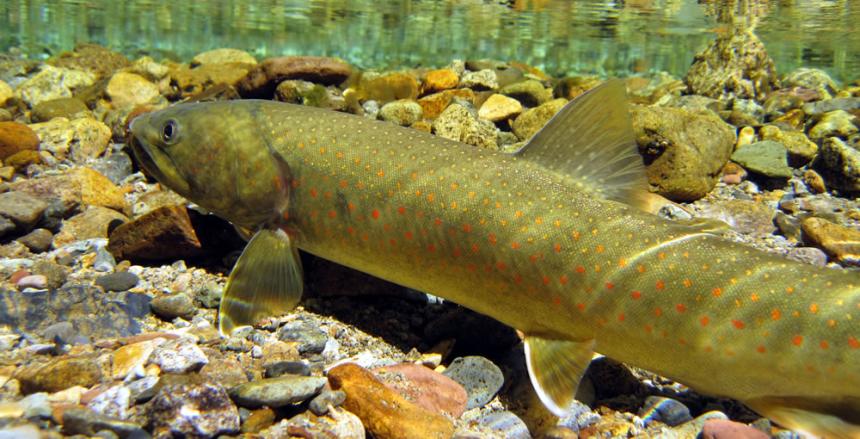Description and Range
Physical description
Even though bull trout are classified as a game fish in Washington most of their populations across the state are listed as "threatened" by the federal Endangered Species Act and therefore they cannot be fished for or kept if accidently caught while fishing. If an angler catches a bull trout in a water closed for bull trout fishing, they must not be taken out of the water. They must be de-hooked and immediately released.
Even though they are called a trout, bull trout are actually a char, closely related to lake trout and brook trout rather than rainbow or cutthroat trout. Also, like lake trout and brook trout their most obvious distinctive feature is light spots on a dark background, unlike rainbow and cutthroat that have dark spots on a lighter background. If an angler is fishing in waters containing bull trout, it is his or her responsibility to be able to identify bull trout and release them immediately, unharmed, if one is accidently caught on hook and line. Their back and sides are olive-green with pale spots about the size of the pupil of their eye. The head and mouth are unusually large and their ventral fins have white leading edges.
Bull trout have different life histories that can vary by individual population. Some spend their entire lives in small streams and their size remains small. Some migrate from small streams to larger rivers and back again to the stream to spawn. Those fish are generally larger. Some migrate into lakes or reservoirs then back to their natal stream or river to spawn. The varying life histories have an influence on maximum size, from 10 to 12 inches to over 30 inches and many pounds in weight.
Average 12-20 inches. Bull trout can grow to 20+ inches (and several pounds) in quality populations.
Where you may encounter bull trout
Notice: It is unlawful to totally remove salmon, steelhead, or Dolly Varden/bull trout from the water if it is unlawful to retain those fish, or if the angler subsequently releases the salmon, steelhead, Dolly Varden/bull trout. See individual lake pages for additional information.
Lakes where this species may be found
How to fish for bull trout
Bull trout are predacious fish and are generally aggressive and will take a variety of artificial lures or flies that resemble fish; spoons, rapalas, etc. Since the only waters in the state that are open to bull trout fishing are rivers, casting would be the technique of choice.
Bull trout prefer cold, well-oxygenated water, but again, legal angling for them is only in the above-mentioned rivers in the specific reaches described in the regulations pamphlet.
Remember, when handling any fish you intend to release, wet your hands first so you don't take off the fish's protective slippery coating. Dry hands will remove the protective coating and make the fish vulnerable to bacterial or fungal infections, which can kill them.
State record
- Weight
- 22.50 lbs
- Angler
- Louis Schott
- Location
- Tieton River, Yakima County
- Date Caught
- April 23, 1961

